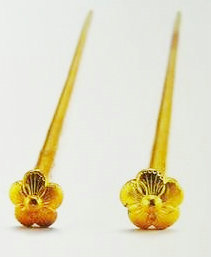Hair ornaments worn by women of wealth also took the form of gold flowers encrusted with jewels depicting flowers or animals.
Among popular decorative patterns were auspicious birds and beasts, such as the dragon, phoenix, crane, deer and the 12 animals of the Chinese "zodiac." The deer was considered a propitious animal because its pronunciation in Chinese is the same as that for six, which denotes success. Hairpins in the design of a mandarin duck denoted married bliss. Patterns of flowers and fruit-bearing trees featured the peony, lotus flower, plum, guava and asphodel. The five petals on a plum represent blessings, high-salary, longevity, luck and wealth.

Designs depicting auspicious objects included musical instruments, chess pieces, calligraphic characters, and the "four treasures of the scholar's studio" comprising the calligraphy brush, ink stick, ink slab and paper.
But to the women of ancient China the ji was far more than just a hair ornament. The ji ceremony, which bestowed a hairpin upon a young woman when she reached the age of 15, was a rite of passage signifying that she had reached marriageable age.
A hairpin also functioned as a love token. When Chinese lovers of ancient times were forced to part they would often split a hairpin, both keeping a half with them at all times until they were reunited.
